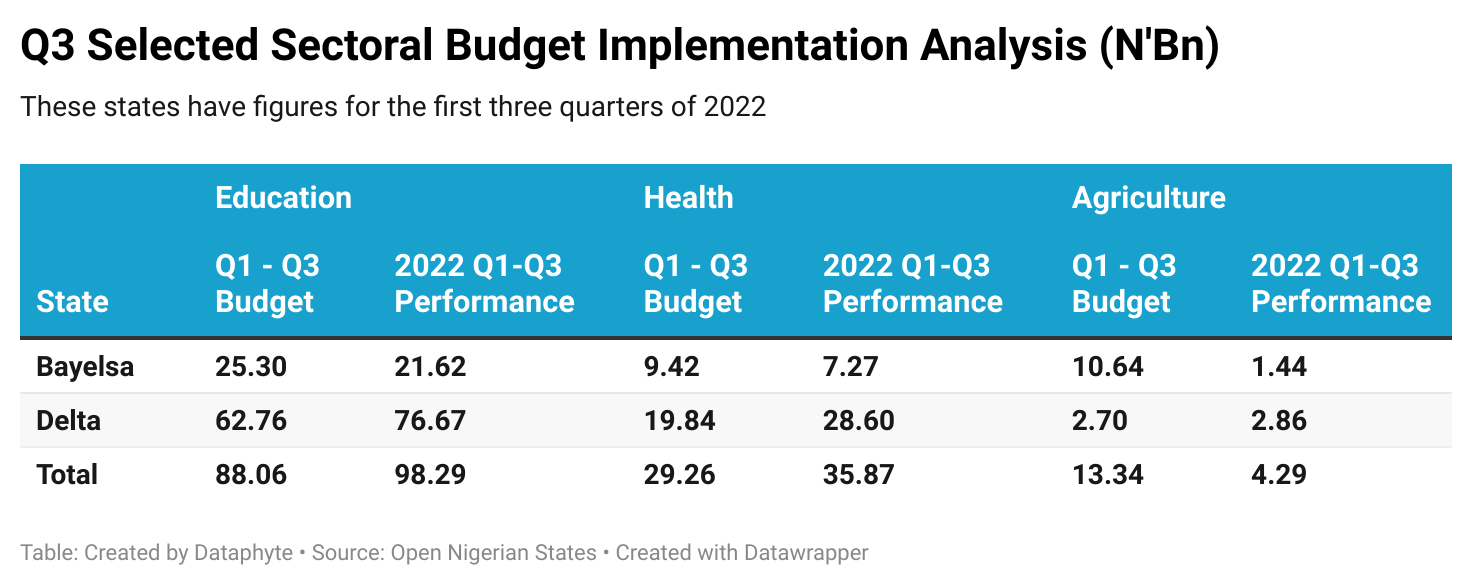Delta State’s performance in the 2022 budget stands out among peers in the South-South.
A review of three selected sectors – education, health, and agriculture – shows that education recorded 122.17 percent performance in Delta State by the end of the third quarter of 2022. The health sector had 144.16 percent performance while agriculture reported 105.9 percent implementation result.
Thus, the state spent not only its pro rata budget for the sectors by the end of Q3, it also spent more than the budgeted funds.
A breakdown shows that Delta State budgeted N62.76 billion for education for the first three quarters but spent N76.67 billion. For health, the state earmarked N19.84 billion but spent N28.6 billion. Also, N2.86 billion was spent on agriculture from a budget of N2.69 billion.
By the end of the third quarter of 2022, Bayelsa State had a performance of 85.46 percent in education, 77.19 percent in health, and 13.48 percent in agriculture.

With the budget implementation reports for just the first two quarters, Edo State’s education budget performed at 81.55 percent, the health sector at 53.13 percent, and agriculture at 38.09 percent.
By the end of the second quarter, Cross River had 21.19 percent performance in education, 25.15 percent in health, and 15.56 percent in agriculture.
However, Rivers State had its report for just the first quarter. Its education sector performed at 55.75 percent, health sector returned 23.9 percent implementation, while agriculture performance stood at 27.22 percent.
.png)
Health sector
The health sector received varying degrees of allocations by the states in the region. Also, the performances of the budget reflect state preferences and implementation plans.
Delta State had the highest budget for health across the region. The state budgeted N19.84 billion for the health sector. By the end of the third quarter, it had spent N28.6 billion on the sector. This reflects that the state spent more than it budgeted for the health sector.
Bayelsa State budgeted N9.42 billion for the health sector but spent N7.27 billion of this budget by the end of Q3 2022.
.png)
In Cross River State, N11.19 billion was budgeted, but only N2.82 billion was spent. Also, N4.42 billion was spent in Edo State out of a budget of N8.32 billion. Rivers State spent just N2.14 billion of its N8.97 billion budget.
The health expenditure performance in the region stood at 77.19 percent in Bayelsa State, 25.15 percent in Cross River State, 144.16 percent in Delta State, 53.13 percent in Edo State, and 23.90 percent in Rivers State.
Despite the varying percentage performances of health budgets across the states, most of these funds went to recurrent expenditure. The states in the region spent just between 0 to 36 percent of their health budgets on capital items.
.png)
In Rivers State, no amount was spent on capital expenditure as the state expended all the health budget on recurrent items. In Cross River State, 36 percent of its health expenditure went to capital expenditure.
Bayelsa State spent 29 percent of its N7.27 billion health budget on capital items while Edo’s capital expenditure share was 23 percent.
Delta State, which had the best performance, spent more than it budgeted. However, it committed only 19 percent to capital expenditure.
Education sector
Delta State’s performance is also above 100 percent in the education sector. The state budgeted N62.76 billion but spent N76.67 billion on education. This reflects a 122.17 percent performance.
On the other hand, Bayelsa had an 85.46 percent performance, 21.19 percent in Cross River, 81.55 percent in Edo State, and 55.75 percent in Rivers State.
.png)
In terms of state allocation to the education sector, Delta State allocated the most in the region to education, while Edo State made the least budget for education.
However, a large chunk of Edo’s education spending was on capital projects. Of the N9.88 billion it spent on education, 60 percent was used to finance capital projects.
.png)
About 33 percent of Bayelsa’s education expenditure went to capital projects, with 29 percent of Delta’s budget going to capital items. However, Cross River and Rivers states spent nothing on capital expenditure within the period.
Agricultural sector
In the agriculture sector, Bayelsa State had the highest budget for the sector in the region. The state budgeted N10.65 billion for agriculture but spent just N1.44 billion.
Cross River budgeted N3.1 billion on agriculture but spent N482.6 million by the end of Q2 2022.
Though Delta State didn’t have the highest budget for agriculture in the region, just like it was the case was in health and education, the state spent more than it budgeted. It budgeted N2.7 billion but spent N2.85 billion.
In Edo State, N2.78 billion was budgeted, but N1.06 billion was spent. On the other hand, N4.45 billion was earmarked in Rivers but only N1.21 billion was spent.
.png)
The analysis shows that 13.48 percent of the agriculture budget was implemented in Bayelsa State. It was 15.56 percent in Cross River State and 105.90 percent in Delta State. Edo State had a 38.09 percent performance whereas Rivers reported 27.22 percent implementation success.
Delta and Cross River states spent most of their agriculture budgets on capital projects. While Cross River spent 92 percent of its agriculture expenditure on capital items, Delta expended 90 percent.
.png)
Of the N1.44 billion spent by Bayelsa State, 35 percent went to capital expenditure. On the other hand, 22 percent of Edo State’s N1.06 billion was spent on capital projects.
Of the three sectors reviewed, agriculture is the only area where Rivers spent more than it budgeted on capital projects. The state had a capital to recurrent ratio in the agriculture sector of 22 to 88 percent.
Sectoral analysis in the region reveals that Delta State spent more than it budgeted on health, education, and agriculture.
“These are mainly oil-producing states, and nothing stops them from requesting supplementary budgets and ensuring 100 percent implementation. One of the reasons for high unemployment rate in the region could be that budgets are poorly implemented and cannot make visible impaact on people’s lives,” said a Lagos-based economist, Adejare Omuwumi.




.png)
.png)
.png)
.png)
.png)
.png)
.png)